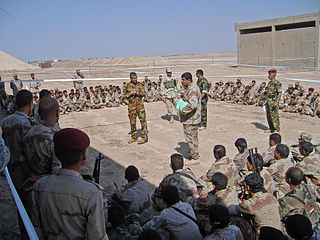
A cluster munition is a form of air-dropped or ground-launched explosive weapon that releases or ejects smaller submunitions. Commonly, this is a cluster bomb that ejects explosive bomblets that are designed to kill personnel and destroy vehicles. Other cluster munitions are designed to destroy runways or electric power transmission lines.

An improvised explosive device (IED) is a bomb constructed and deployed in ways other than in conventional military action. It may be constructed of conventional military explosives, such as an artillery shell, attached to a detonating mechanism. IEDs are commonly used as roadside bombs, or homemade bombs.

Al-Iskandariya or Alexandria is an ancient city in central Iraq, one of a number of towns in the Near East founded by and named after Alexander the Great. It is a majority Shia Arab district including Musayyib and Jurf Al Sakhr. The district capital is located about 70 kilometres (45 mi) south of Baghdad, near the Euphrates River.

After the 2003 invasion of Iraq was completed and the regime of Saddam Hussein was toppled in May 2003, an Iraqi insurgency began that would last until the United States left in 2011. The 2003–2006 phase of the Iraqi insurgency lasted until early 2006, when it escalated from an insurgency to a Sunni-Shia civil war, which became the most violent phase of the Iraq War.

The Triangle of Death is a name given to a region south of Baghdad during the 2003–2011 occupation of Iraq by the U.S. and allied forces which saw major combat activity and sectarian violence from early 2003 into the fall of 2007.
Events in the year 2005 in Iraq.

Insurgency weapons and tactics (IWAT) are weapons and tactics, most often involving firearms or explosive devices, intended for use by insurgents to engage in guerrilla warfare against an occupier, or for use by rebels against an established government. One type of insurgency weapon are "homemade" firearms made by non-professionals, such as the Błyskawica (Lightning) submachine gun produced in underground workshops by the Polish resistance movement. One weapon that is part of the conventional military arsenal but which has been taken up to great effect by insurgents, is the RPG. Two examples of an improvised weapon used by insurgents would be the improvised explosive devices used in Iraq and the Molotov cocktails used against vehicles and tanks. Two tactics used by many insurgents are assassinations and suicide bomb attacks. The latter tactic is used when an insurgent has a bomb strapped to them or in their car, which provides a low-tech way for insurgents to get explosives close to critical enemy targets.

The Battle of Abu Ghraib took place between Iraqi Mujahideen and United States forces at Abu Ghraib prison on April 2, 2005.
Operation Together Forward, also known as Forward Together, was an unsuccessful offensive against sectarian militias in Baghdad to significantly reduce the violence in which had seen a sharp uprise since the mid-February 2006 bombing of the Askariya Mosque, a major Shiite Muslim shrine, in Samarra.
The tactics of the Iraqi insurgency have varied widely. Insurgents have targeted U.S. forces and Iraqi government forces using improvised explosive devices, ambushes, snipers, and mortar and rocket fire, in addition to using car bombs, kidnappings or hostage-taking, and assassinations.

Operation Commando Eagle was a 2007 military operation of the Iraq War. It began on 21 June 2007, when Iraqi and Coalition forces launched a combined ground and air assault operation against Islamic State of Iraq and other extremist terrorists operating in the Mahmudiyah region of Babil province. The action was intended to curb terrorist activity southwest of Baghdad through a mix of helicopter assaults and Humvee-mounted movements.
During the Iraq War, the Ramadan Offensive of the Iraqi insurgency marked a sharp increase in the number of violent attacks against the American-led military coalition in Iraq and also against the new Iraqi government, beginning in the end of October 2003 and persisting for most of November 2003.
Operation Phantom Phoenix was a major nationwide offensive launched by the Multinational Force Iraq (MNF-I) on 8 January 2008 in an attempt to build on the success of the two previous corps-level operations, Operation Phantom Thunder and Operation Phantom Strike and further reduce violence and secure Iraq's population, particularly in the capital Baghdad. The offensive consisted of a number of joint Coalition and Iraqi Army operations throughout northern Iraq as well as in the southern Baghdad Belts.
The 2005 Hit convoy ambush was an ambush by Iraqi insurgents of a convoy that was carrying military supplies for U.S. forces. The convoy was escorted by private military contractors. The ambush ended with the death of all the contractors.

Kata'ib Hezbollah, also known as the Hezbollah Brigades, is a radical Iraqi Shiite paramilitary group which is a part of the Iraqi Popular Mobilization Forces (PMF), staffing the 45th, 46th, and 47th Brigades. During the Iraq War (2003–11), the group fought against Coalition forces. It has been active in the War in Iraq (2013–2017) and the Syrian Civil War. The group was commanded by Abu Mahdi al-Muhandis until he was killed in a US drone attack in 2020. Thereafter, Abdul Aziz al-Muhammadawi became the new leader of the PMF. The group seeks to establish an Iran-aligned government in Iraq, expel American forces from the country, and advance the regional and international interests of Iran in Iraq and the region. The group is responsible for killing hundreds of U.S. soldiers and takes a central part in carrying out attacks against U.S. targets in Iraq and acts as part of the Axis of Resistance. Kata'ib Hezbollah has received extensive training, funding, logistic support, weapons, and intelligence from the IRGC's overseas military-intelligence service Quds Force.
The Sheibani Network was an Iraqi smuggling network and Shi'a Insurgent group led by Abu Mustafa al-Sheibani, an ex-commander of the Supreme Council for Islamic Revolution in Iraq's Badr Brigades. The Badr Brigades' militiamen and supply lines became known collectively as the “Sheibani Network,” which maintained links to Asa'ib Ahl al-Haq (AAH) and to Kata'ib Hezbollah. The group was believed to be used by Iran's Revolutionary Guards' Quds Force to supply Iraqi Special Groups. The group is alleged to be responsible for numerous attacks on Iraqi and Coalition forces. In 2009 the American Enterprise Institute believed that the network consisted of 280 members, divided in 17 units. US commanders estimated that weapons smuggled and used by the group were responsible for the death of 170 and injuries to 600 American soldiers by February 2007. Beginning in February 2013, reports from Iraqi newspapers Al Masalah and Kitabat claimed splits had emerged within Kata'ib Hezbollah, leading to the expulsion of al-Sheibani as its leader. In May 2013 al-Sheibani founded Kata'ib Sayyid al-Shuhada, but retired from his role as leader in 2014 when he became an advisor to Iraqi Interior Minister Mohammed Al-Ghabban.
Animal-borne bomb attacks are the use of animals as delivery systems for explosives. The explosives are strapped to a pack animal such as a horse, mule or donkey. The pack animal may be set off in a crowd.

A barrel bomb is an improvised unguided bomb, sometimes described as a flying IED. They are typically made from a large barrel-shaped metal container that has been filled with high explosives, possibly shrapnel, oil or chemicals as well, and then dropped from a helicopter or aeroplane. Due to the large amount of explosives, their poor accuracy, and indiscriminate use in populated civilian areas, the resulting detonations have been devastating. Critics have characterised them as weapons of terror and illegal under international conventions.

Improvised artillery in the Syrian Civil War are improvised weapons created and used by factions of the Syrian Civil War, most notably Syrian opposition forces. The weapons include the Hell-Cannon and its variants, the Thunder Cannon and the Mortar Cannon.
On 14 September 2017, several members of ISIL staged multiple attacks on the outskirts of Nasiriyah in the southern Dhi Qar Governorate, Iraq, killing at least 84 people and injuring 93 others.












